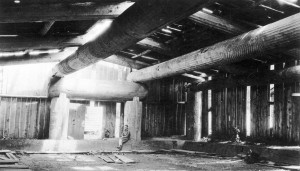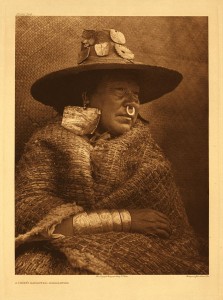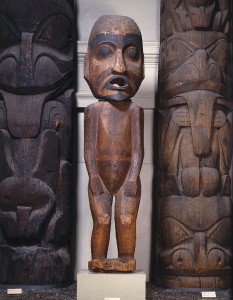13.2 Aboriginal Societies in the 18th Century

Simon Fraser’s arrival at Camchin (Lytton), at the confluence of the Thompson and Fraser Rivers was foretold. Among the Nlaka’pamux around the end of the 18th century there was a prophecy that foreigners would arrive from the east — although in some respects, they had already arrived.
The Proto-Contact Years
The fur trade on the Plains and the intrusion of Spanish goods — including horses — impacted Aboriginal peoples in the northern reaches of the Columbia basin (the Okanagan and Thompson Valleys) and in the Kootenay valleys. Knowing this, it is possible — indeed, probable — that smallpox arrived in the Cordillera long before the first European appeared. Epidemics in the 1730s and 1760s could have been passed along trade or raid routes, especially once so many of the neighbours to the south and east were able to travel on horseback. The 1780s smallpox epidemic definitely made an appearance. And when Fraser arrived in 1808 he found evidence of European trade commodities among the Nlaka’pamux, proof that there was no such thing as total isolation in this region. It remains uncertain as to when the proto-contact period precisely began in the Interior of what is now British Columbia, but we can be confident that the world encountered by Euro-North Americans from the 1770s on was one undergoing great change.
Notwithstanding the proto-contact experience, Aboriginal societies in the Pacific Northwest enjoyed prolonged isolation from the European invasion taking place in Mexico, the Mississippi, the parklands of the North, and the eastern woodlands. From 1500 to the 1740s, indigenous cultures and populations continued to thrive. There is nothing in the written, oral, archaeological, or geological record to suggest any catastophes to rival the volcanic explosions of about 2,000 and 1,000 years earlier; nothing that would force a massive migration wave. (It is the case, to be sure, that seismic issues are a fact of life in the region. One local traditional understanding of their cause conveys a very usable image of what contemporary science believes occurs: “According to the Nuxalk … a giant supernatural being held the earth in ropes. When he adjusted his grip, or when the rope slipped in his hands, the Nuxalk could feel the tremors and performed a ceremonial earthquake dance.”)[1] The southward movement of Athabaskan speakers appears to have been complete by 1400. After this time the pattern of culture groups seems to have coalesced into the form that enters the European record from the 1740s on.
There are three culture areas in what is now British Columbia: Subarctic, Northwest Coast, and Interior Plateau. Each of these extends beyond the province’s boundaries to, respectively, the East and North, the Columbia Basin, and from California to Alaska. Each group made use of winter villages, which tended to be larger concentrations of population that combined food and fuel resources to make it through the season. Most, too, had summer villages or summer ranges where resources of all kinds would be gathered or harvested. This pattern implies the regular migration of significant numbers of people to sites of economic and cultural importance. A large range of land- and seascapes could be utilized without establishing permanence in any of them. Even the huge cedar longhouses that are the trademark of coastal cultures could be dismantled almost entirely and the heavy planks floated to another site. Records from the contact era of what appear to be abandoned villages continue to provoke debate among scholars and in the courtroom: were they truly abandoned, just swapped out temporarily for a second location, or ruined by war and/or disease?

Village Cultures
The longhouse was a defining feature of Aboriginal coastal life. Great numbers of people associated with distinct clans occupied these buildings that could be the size of a modern football field. As storehouses, homes, and theatres for celebrations and performances, longhouses were among the largest and grandest structures in North America into the 19th century. The Northwest Coast culture developed along stratified, hierarchical lines that included a nobility, a commoner class, and slaves; their relative status was reflected in their living space in the longhouse.
The complexity and sophistication of longhouse decoration was also important. Population health and size was almost guaranteed by the wealth of food sources available along the coast — including whales on the west coast of Vancouver Island. Over time, large and prosperous populations developed a culture reflected in arts, sculpture, dance, storytelling, and specialized roles in hunting, fishing, and warfare. Village populations often grew to be more than 1,000 people, and the larger ethnic zones might include 10,000 to 20,000 individuals. Opitsaht in 1792 was said to contain “200 houses, generally well built” with an estimated population of 2,500.[2]

Subarctic culture groups were much smaller and tended toward an egalitarian model. Families constituted the basic social unit and the favourable seasons were devoted to a wide-ranging hunting-gathering routine. Recent research has demonstrated that Subarctic peoples also engaged in horticulture, refashioning the landscape with fire to encourage the growth of berry patches and roots.
Interior Plateau peoples focused on riverine resources, particularly the salmon runs. In the winter, they lived in the kekuli or pithouse. Populations were never as high as those on the coast, but winter villages were substantial and numbers were higher than among the Subarctic peoples. Access to the Columbia River system put this group into closer contact with peoples of the Plains tradition and with cultures deep in the American southwest.
Trade across these three culture regions was extensive and regular, and they shared both linguistic and political connections: Interior peoples like the Nlaka’pamux had connections with Stó:lō peoples in the lower Fraser Valley, commercial and military alliances that were facilitated by their common language group (Salishan). In other instances, common language was no more a guarantee against rivalry than being part of the Iroquoian language pool protected the Wendat from the Haudenosaunee. And alliances crossed lingustic and culture zones: the Tsilhqot’in (Athabaskan speakers) and the Nuxalk (Salishan speakers) brought together Northwest Coast, Subarctic, and Interior Plateau traditions when they gathered for trade and support.[3]

What marks the region as a whole is diversity of peoples and languages and a similarity of economies and food traditions. Almost everyone harvested salmon from the rivers and hunted for large land mammals. And everyone traded.
On the coast in particular the accumulation of wealth was especially important because it served the ceremony known as the potlatch. Principally, the potlatch involved gift-giving to mark a key event, such as a succession, a coming of age, or a political anniversary. The scale of the gift-giving — the magnitude of generosity and hospitality — reflected the status of the host. These events also served as a means to announce changes or events of some importance, and the guests as recipients of gifts would be expected to bear witness. The potlatch was also a means of redistributing wealth. When the salmon runs were strong (at least once every four years), canyon peoples built up substantial surpluses; when the runs failed, as they did from time to time, coastal peoples were better positioned. Potlatching in this context was a kind of mutual support system.[4]

The Contact Era
The arrival of the trans-Pacific sea otter trade, which opened up the West Coast to intercontinental commerce, had a significant impact on Aboriginal societies, not least of which was the introduction of exotic diseases. Although most if not all of these nations were impacted by smallpox (beginning probably in the 1780s, perhaps earlier), the magnitude of the mortality is both unknown and likely uneven. In some cases it was disastrous. (The Sinixt people of the Arrow Lakes are thought to have been reduced by 80% in the 1781 smallpox epidemic, for example.) As well, recovery rates are completely a mystery. Further and cataclysmic epidemics occurred in the 1830s and the 1860s, some of which are considered later in this chapter.
Scholars, Aboriginal peoples, and the courts debate the probable pre-contact numbers west of the Rockies. Some estimates are modest, ranging from 80,000 to 100,000. Others are as high as 350,000, and there are outlier estimates in excess of 1 million. The matter is complicated by eyewitness accounts like those of George Vancouver, who saw abandoned villages, half disassembled, and assumed they indicated a disaster involving loss of life. But the business of seasonal movements between village and resource sites can account for some of the empty lands that were reported. Archaeological research has yet to provide a reliable means of estimating the pre-contact numbers. Nor can we be sure when smallpox first struck, partly because it doesn’t leave a “fingerprint” on the victim the way some skeletal diseases or bone trauma from combat might.
What we know for sure is that wherever Europeans went on the coast, they reported the existence of large villages with equally impressive longhouses. Communities may have been farther apart in the Interior, but some were, according to NWC reports, nodes of 1,000 or more. We can also be confident that, given what we know about virgin soil diseases, those well-developed village communities with their high densities and even the kekuli pits of the Interior were a good environment for highly contagious diseases to thrive in. Around 1860 there were maybe 80,000 Aboriginal peoples in the region; not only did they outnumber the newcomers, they outnumbered all the other Aboriginal peoples in British North America combined. Their number at the time of contact could only have been larger.
These numbers and the complexity of the Aboriginal world west of the Rockies would insulate indigenous cultures from externally imposed change for a while. Historians disagree on this point, but it is safe to say that much of the cultural change that occurred along the Pacific Northwest coast until the 1840s was controlled mainly by the Aboriginal peoples and not by the Europeans.
Key Points
- Aboriginal societies west of the Rockies faced little to no direct exposure to Europeans prior to the 1740s.
- Indigenous cultures can be grouped into three broad categories: Subarctic, Northwest Coast, and Interior Plateau.
- While each share some common features, there are important distinctions as well.
- Trade between Aboriginal communities and nations was extensive both in terms of the distances travelled and the commodities exchanged.
- The potlatch is an important feature of the regional economy, political and social order, and wider cultural life on the West Coast, into which newcomer goods fit very well.
- Populations west of the Rockies and especially on the northwest coast were larger than anywhere else in North America.
Attributions
Figure 13.2
Haida by Albert P. Niblack is from the Canadian Museum of History and cannot be used for commercial purposes.
Figure 13.3
Interior of longhouse under construction by Matthews, James Skitt, Major is in the public domain. This image is available from City of Vancouver Archives under item: In P105.2.
Figure 13.4
Nakoaktok by Para is in the public domain.
Figure 13.5
Stolo with dipnets by Themightyquill is in the public domain.
Figure 13.6
Speaker Figure, 19th century was uploaded as a donation by the Brooklyn Museum, and is considered to have no known copyright restrictions by the institutions of the Brooklyn Museum.
- William J. Turkel, The Archive of Place: Unearthing the Pasts of the Chilcotin Plateau (Vancouver: UBC Press, 2007), 122. ↵
- John Boit,1792, quoted in George Woodcock, British Columbia: A History of the Province (Vancouver: Douglas & McIntyre, 1990), 57; Daniel W. Clayton, Islands of Truth: The Imperial Fashioning of Vancouver Island (Vancouver: UBC Press, 2000), 132. ↵
- Robert J. Muckle, The First Nations of British Columbia (Vancouver: UBC Press, 1998), 32-7. ↵
- A useful discussion of potlatching can be found in Turkel, The Archive of Place, 131. ↵

